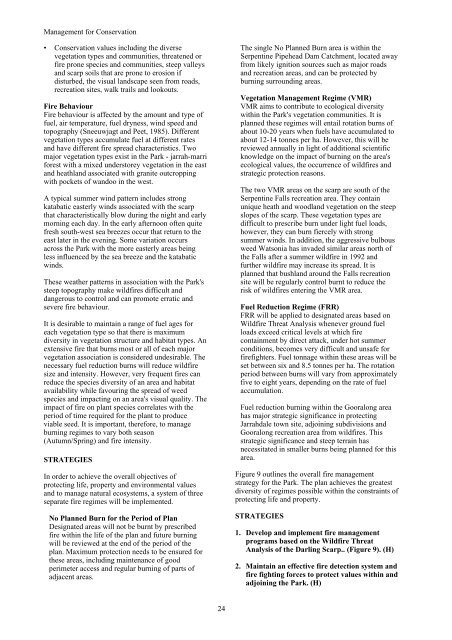Serpentine National Park - Department of Environment and ...
Serpentine National Park - Department of Environment and ...
Serpentine National Park - Department of Environment and ...
Create successful ePaper yourself
Turn your PDF publications into a flip-book with our unique Google optimized e-Paper software.
Management for Conservation<br />
• Conservation values including the diverse<br />
vegetation types <strong>and</strong> communities, threatened or<br />
fire prone species <strong>and</strong> communities, steep valleys<br />
<strong>and</strong> scarp soils that are prone to erosion if<br />
disturbed, the visual l<strong>and</strong>scape seen from roads,<br />
recreation sites, walk trails <strong>and</strong> lookouts.<br />
Fire Behaviour<br />
Fire behaviour is affected by the amount <strong>and</strong> type <strong>of</strong><br />
fuel, air temperature, fuel dryness, wind speed <strong>and</strong><br />
topography (Sneeuwjagt <strong>and</strong> Peet, 1985). Different<br />
vegetation types accumulate fuel at different rates<br />
<strong>and</strong> have different fire spread characteristics. Two<br />
major vegetation types exist in the <strong>Park</strong> - jarrah-marri<br />
forest with a mixed understorey vegetation in the east<br />
<strong>and</strong> heathl<strong>and</strong> associated with granite outcropping<br />
with pockets <strong>of</strong> w<strong>and</strong>oo in the west.<br />
A typical summer wind pattern includes strong<br />
katabatic easterly winds associated with the scarp<br />
that characteristically blow during the night <strong>and</strong> early<br />
morning each day. In the early afternoon <strong>of</strong>ten quite<br />
fresh south-west sea breezes occur that return to the<br />
east later in the evening. Some variation occurs<br />
across the <strong>Park</strong> with the more easterly areas being<br />
less influenced by the sea breeze <strong>and</strong> the katabatic<br />
winds.<br />
These weather patterns in association with the <strong>Park</strong>'s<br />
steep topography make wildfires difficult <strong>and</strong><br />
dangerous to control <strong>and</strong> can promote erratic <strong>and</strong><br />
severe fire behaviour.<br />
It is desirable to maintain a range <strong>of</strong> fuel ages for<br />
each vegetation type so that there is maximum<br />
diversity in vegetation structure <strong>and</strong> habitat types. An<br />
extensive fire that burns most or all <strong>of</strong> each major<br />
vegetation association is considered undesirable. The<br />
necessary fuel reduction burns will reduce wildfire<br />
size <strong>and</strong> intensity. However, very frequent fires can<br />
reduce the species diversity <strong>of</strong> an area <strong>and</strong> habitat<br />
availability while favouring the spread <strong>of</strong> weed<br />
species <strong>and</strong> impacting on an area's visual quality. The<br />
impact <strong>of</strong> fire on plant species correlates with the<br />
period <strong>of</strong> time required for the plant to produce<br />
viable seed. It is important, therefore, to manage<br />
burning regimes to vary both season<br />
(Autumn/Spring) <strong>and</strong> fire intensity.<br />
STRATEGIES<br />
In order to achieve the overall objectives <strong>of</strong><br />
protecting life, property <strong>and</strong> environmental values<br />
<strong>and</strong> to manage natural ecosystems, a system <strong>of</strong> three<br />
separate fire regimes will be implemented.<br />
No Planned Burn for the Period <strong>of</strong> Plan<br />
Designated areas will not be burnt by prescribed<br />
fire within the life <strong>of</strong> the plan <strong>and</strong> future burning<br />
will be reviewed at the end <strong>of</strong> the period <strong>of</strong> the<br />
plan. Maximum protection needs to be ensured for<br />
these areas, including maintenance <strong>of</strong> good<br />
perimeter access <strong>and</strong> regular burning <strong>of</strong> parts <strong>of</strong><br />
adjacent areas.<br />
24<br />
The single No Planned Burn area is within the<br />
<strong>Serpentine</strong> Pipehead Dam Catchment, located away<br />
from likely ignition sources such as major roads<br />
<strong>and</strong> recreation areas, <strong>and</strong> can be protected by<br />
burning surrounding areas.<br />
Vegetation Management Regime (VMR)<br />
VMR aims to contribute to ecological diversity<br />
within the <strong>Park</strong>'s vegetation communities. It is<br />
planned these regimes will entail rotation burns <strong>of</strong><br />
about 10-20 years when fuels have accumulated to<br />
about 12-14 tonnes per ha. However, this will be<br />
reviewed annually in light <strong>of</strong> additional scientific<br />
knowledge on the impact <strong>of</strong> burning on the area's<br />
ecological values, the occurrence <strong>of</strong> wildfires <strong>and</strong><br />
strategic protection reasons.<br />
The two VMR areas on the scarp are south <strong>of</strong> the<br />
<strong>Serpentine</strong> Falls recreation area. They contain<br />
unique heath <strong>and</strong> woodl<strong>and</strong> vegetation on the steep<br />
slopes <strong>of</strong> the scarp. These vegetation types are<br />
difficult to prescribe burn under light fuel loads,<br />
however, they can burn fiercely with strong<br />
summer winds. In addition, the aggressive bulbous<br />
weed Watsonia has invaded similar areas north <strong>of</strong><br />
the Falls after a summer wildfire in 1992 <strong>and</strong><br />
further wildfire may increase its spread. It is<br />
planned that bushl<strong>and</strong> around the Falls recreation<br />
site will be regularly control burnt to reduce the<br />
risk <strong>of</strong> wildfires entering the VMR area.<br />
Fuel Reduction Regime (FRR)<br />
FRR will be applied to designated areas based on<br />
Wildfire Threat Analysis whenever ground fuel<br />
loads exceed critical levels at which fire<br />
containment by direct attack, under hot summer<br />
conditions, becomes very difficult <strong>and</strong> unsafe for<br />
firefighters. Fuel tonnage within these areas will be<br />
set between six <strong>and</strong> 8.5 tonnes per ha. The rotation<br />
period between burns will vary from approximately<br />
five to eight years, depending on the rate <strong>of</strong> fuel<br />
accumulation.<br />
Fuel reduction burning within the Gooralong area<br />
has major strategic significance in protecting<br />
Jarrahdale town site, adjoining subdivisions <strong>and</strong><br />
Gooralong recreation area from wildfires. This<br />
strategic significance <strong>and</strong> steep terrain has<br />
necessitated in smaller burns being planned for this<br />
area.<br />
Figure 9 outlines the overall fire management<br />
strategy for the <strong>Park</strong>. The plan achieves the greatest<br />
diversity <strong>of</strong> regimes possible within the constraints <strong>of</strong><br />
protecting life <strong>and</strong> property.<br />
STRATEGIES<br />
1. Develop <strong>and</strong> implement fire management<br />
programs based on the Wildfire Threat<br />
Analysis <strong>of</strong> the Darling Scarp.. (Figure 9). (H)<br />
2. Maintain an effective fire detection system <strong>and</strong><br />
fire fighting forces to protect values within <strong>and</strong><br />
adjoining the <strong>Park</strong>. (H)

















